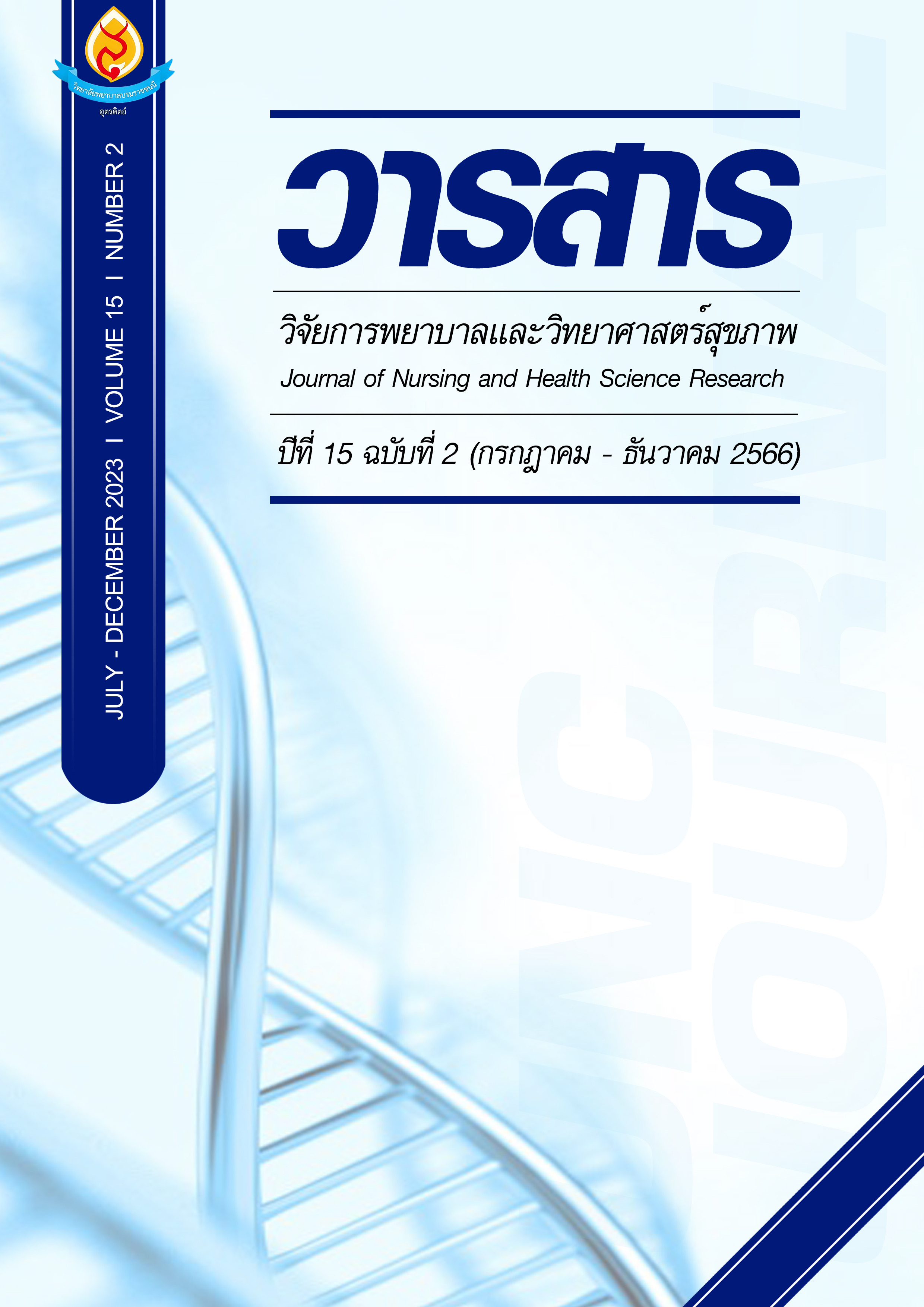ปัจจัยที่มีผลต่อพฤติกรรมการดูแลสุขภาพของคนในชุมชนชนบทไทย: ประสบการณ์จากภาคเหนือตอนล่างประเทศไทย
Main Article Content
บทคัดย่อ
ปัจจัยที่มีผลต่อพฤติกรรมการดูแลสุขภาพของคนในชุมชนชนบทไทย: ประสบการณ์จากภาคเหนือตอนล่างประเทศไทย มีวัตถุประสงค์ 1) เพื่อศึกษาสถานการณ์และปัญหาต่าง ๆ ที่เกี่ยวข้องในระบบการส่งเสริม ป้องกัน รักษาโรค ฟื้นฟูสมรรถภาพและพฤติกรรมการดูแลสุขภาพของคนในชุมชนชนบท อำเภอบ้านตาก จังหวัดตาก โดยกลุ่มตัวอย่างทีมสหสาขาวิชาชีพที่ทำงานรับผิดชอบในการดูแลผู้ป่วยโรคไม่ติดต่อเรื้อรัง จำนวน 30 คน สุ่มตัวอย่างแบบเจาะจงโดยใช้แบบสัมภาษณ์เชิงลึก 2) เพื่อศึกษาพฤติกรรมการดูแลสุขภาพตนเองของคนในชุมชนชนบท และ 3) เพื่อศึกษาปัจจัยทำนายพฤติกรรมการดูแลสุขภาพของคนในชุมชนชนบท ทฤษฎีการดูแลตนเองของ Orem และ PRECEDE Framework ของ Green ถูกนํามาใช้เป็นกรอบแนวคิดในการวิจัย ใช้วิธีการแบบผสมโดยผสมผสานวิธีการเชิงปริมาณและวิธีการเชิงคุณภาพ กลุ่มตัวอย่างเป็นประชาชน อายุ 18 ปีขึ้นไป จำนวน 200 คน ซึ่งสุ่มโดยวิธีจับฉลาก เก็บข้อมูลโดยใช้แบบสอบถามพฤติกรรมการดูแลตนเองของประชาชน สำหรับวิธีวิจัยเชิงคุณภาพใช้กระบวนการสืบค้นข้อมูลต่าง ๆ ที่เกี่ยวข้องกับพฤติกรรมการดูแลตนเอง ปัจจัยนำ ปัจจัยเอื้อ และปัจจัยเสริมที่เกี่ยวข้องกับพฤติกรรมการดูแลตนเองของประชาชน ตามกรอบแนวคิด PRECEDE Framework
ผลการศึกษาสถานการณ์และปัญหาต่างๆ ที่เกี่ยวข้องกับปัจจัยที่โรคไม่ติดต่อเรื้อรัง จากการสัมภาษณ์เชิงลึกผู้ให้ข้อมูล มี 4 ประเด็นหลัก ได้แก่ 1) การคัดกรอง ค้นหาผู้ป่วยเสี่ยงและผู้ป่วยรายใหม่ 2) ระบบการป้องกันผู้ป่วยโรคไม่ติดต่อเรื้อรัง การรักษาและการฟื้นฟูสมรรถภาพ 3) การมีส่วนร่วมและการเพิ่มศักยภาพของเครือข่าย และ 4) การใช้เทคโนโลยีทางสุขภาพ พบว่าพฤติกรรมการดูแลตนเองในภาพรวม (ด้านการรับประทานอาหาร การออกกำลังกาย การจัดการความเครียด และการรับประทานยา) อยู่ในระดับปานกลาง ส่วนปัจจัยนำ (ความรู้ ทัศนคติ) ปัจจัยเอื้อ (การเข้าถึงสถานพยาบาล) และปัจจัยเสริม (เครือข่ายทางสังคมและการสนับสนุน ) มีความสัมพันธ์กับพฤติกรรมการดูแลตนเองอย่างมีนัยสำคัญทางสถิติ ( p-value < .05) โดยปัจจัยที่สามารถทำนายพฤติกรรมการดูแลตนเองเกี่ยวกับโรคเรื้อรังมากที่สุด คือ การเข้าถึงสถานพยาบาล รองลงมา คือ อายุ พฤติกรรม
จากผลการศึกษามีข้อเสนอแนะ ควรมีการส่งเสริมการพัฒนาทั้งความรู้และทัศนคติในการดูแลสุขภาพเกี่ยวกับโรคไม่ติดต่อเรื้อรัง ควรมีเป้าหมายงานเชิงรุกทำงานแบบสหวิชาชีพที่ชัดเจนในระยะเวลาที่เหมาะสม ปัจจัยที่ร่วมทำนายพฤติกรรมในการศึกษาครั้งนี้ ควรพิจารณาตัวแปรอื่น ๆ ร่วมด้วย ตามบริบทของทั้งผู้ให้บริการและผู้รับบริการเพื่อให้ก่อเกิดแรงสนับสนุนในการดูแลตนเองอย่างมีประสิทธิภาพ
Article Details

อนุญาตภายใต้เงื่อนไข Creative Commons Attribution-NonCommercial-NoDerivatives 4.0 International License.
บทความหรือข้อคิดเห็นใดใดที่ปรากฏในวารสารวิจัยการพยาบาลและวิทยาศาสตร์สุขภาพ เป็นวรรณกรรมของผู้เขียน ซึ่งบรรณาธิการหรือสมาคมศิษย์เก่า ไม่จำเป็นต้องเห็นด้วย และบทความที่ได้รับการตีพิมพ์เผยแพร่ถือเป็นลิขสิทธิ์ของวารสารวิจัยการพยาบาลและวิทยาศาสตร์สุขภาพ
เอกสารอ้างอิง
Bloom, B.S. (1971). Handbook on formative and summative evaluation of student learning. New York: McGraw–Hill.
Boonjian, P. (2016). The development of a network of primary care services. Journal of Preventive Medicine Association of Thailand, 6(1), 38-48. (in Thai).
Chantakeeree, C., Sormunen, M., Estola, M., Jullamate, P. & Turunen, H. (2022). Factors affecting quality of life among older adults with hypertension in urban and rural areas in Thailand: A cross-sectional study. International journal of aging & human development, 95(2), 222–244. https://doi.org/10.1177/00914150211050880
Cohen, J. (1988). Statistical power analysis for the behavioral sciences. (2nd). Hillsdale, NJ: Lawrence Erlbaum Associates, Publishers.
Colorafi, K. J. & Evans, B. (2016). Qualitative descriptive methods in health science research. Health Environments Research and Design Journal, 9(4), 16-25.
Division of Non-Communicable Disease, Department of Disease Control of Thailand. (2020). The international consultation on legislation for prevention and control of noncommunicable diseases in Thailand. Retrieved from
https://ddc.moph.go.th/en/contents.php?contents=121. (in Thai).
Department of Disease Control: DDC, Ministry of Public Health. (2020). Annual report 2020 NCD. Nonthaburi: Department of Disease control. Retrieved from https://bit.ly/31Hrd48. (in Thai).
Green, l.W. & Kreuter, M.W. (2005). Health program planning: An educational and ecological approach. 4th ed. New York: Emily Barrosse.
Intamas, U., Rawiworrakul, T., Amnatsatsue, K., Nanthamongkolcha, S. & Palmer, M. H. (2020). Care of stroke survivors in community: a case study of rural Thai community. Journal of Health Research, 35(1), 77-87.
Liu, K., Cao, H., Guo, C., Pan, L., Cui, Z., Sun, J., Zhao, W., Han, X., Zhang, H., Wang, Z., Niu, K., Tang, N., Shan, G. & Zhang, L. (2021). Environmental and genetic determinants of major chronic disease in Beijing-Tianjin-Hebei Region: protocol for a community-based cohort study. Frontiers in public health, 9, 659701. https://doi.org/10.3389/fpubh.2021.659701
Meier, T., Senftleben, K., Deumelandt, P., Christen, O., Riedel, K. & Langer, M. (2015). Healthcare costs associated with an adequate intake of sugars, salt and saturated fat in Germany: a health econometrical analysis. PloS one, 10(9), e0135990. https://doi.org/10.1371/journal.pone.0135990
Liangruenrom, N., Suttikasem, K., Craike, M., Bennie, J. A., Biddle S. J. & Pedisic, Z. (2018). Physical activity and sedentary behavior research in Thailand: a systematic scoping Review. BMC Public Health, 18,733. https://doi.org/10.1186/s12889-018-5643-y
Kim, J., Jang, J., Kim, B. & Lee, K. H. (2022). Effect of the PRECEDE-PROCEED model on health programs: a systematic review and meta-analysis. Systematic reviews, 11(1), 213. https://doi.org/10.1186/s13643-022-02092-2
Medical Record BanTak Hospital. (2022). Service rate fiscal year 2020-2022. BanTAk Hospital.
Niamlaong, K. (2021). Effect of health promotion on self-care behaviors among patients with uncontrolled hypertension. Health Science Journal of Thailand, 3(1), 50-61. (in Thai).
Ong-Artborirak, P., Katekaew, S., Sorawit, B., Auttama, N. & Prakaipetch, W. (2023). Health literacy, self-efficacy, self-care behaviors, and glycemic control among older adults with type 2 diabetes mellitus: a cross-sectional study in Thai communities. BMC Geriatrics, 2023, 1-10, doi: 10.1186/s12877-023-04010-0
Orem, D. E., Taylor, S. G. & Renpenning, K. M. (2001). Nursing: concepts of practice (6th ed.). St.Louis: Mosby.
Pandey, A. R., Chalise, B., Shrestha, N., Ojha, B., Maskey, J., Sharma, D., Godwin, P. & Aryal, K. K. (2020). Mortality and risk factors of disease in Nepal: trend and projections from 1990 to 2040. PloS one, 15(12), e0243055.
Phinyo, P., Phinyo, K., Mahem, K., Supapinij, C. & Paungtai, P. (2021). Development of self-management guidelines for patients with type 2 diabetes in the semi-urban, semi-rural community. Songklanagarind Journal of Nursing, 41(4), 100-111. (in Thai).
Posai, V., Suksatan, W., Choompunuch, B., Koontalay, A., Ounprasertsuk, J. & Sadang, J. M. (2021). Assessment of the health-promoting behaviors of hospitalized patients with non-communicable diseases during the second wave of COVID-19. Journal of multidisciplinary healthcare, 14, 2185–2194. https://doi.org/10.2147/JMDH.S329344
Pugtarmnag, S. Pranate, N., Thitininniti, Y. & Muangyim, K. (2019). How to build a seamless referral system: a case study of the chang community, Singburi, Thailand. Journal of Health Science Research, 13(1), 136-146. (in Thai).
Quality Assurance Committee BanTak Hospital. (2020). Hospital quality assurance report. Tak: Hospital. (in Thai).
Sardtrakulwatana, V. (2018). The development of a chronic disease clinic model (diabetes, hypertension) in primary care units, Mueang district, Singburi province. Journal of Preventive Medicine Association of Thailand, 8(1), 28-36. (in Thai).
Solod, W. (2022). Sedentary behaviors increases the risk factor of developing non-communicable diseases (NCDs): prevention guidelines. Health Science Journal of Nakhon Ratchasima College, 1(2), 42-59. (in Thai).
World Health Organization [WHO]. (2022). Non communicable diseases. Retrieved from https://www.who.int/health-topics/noncommunicable-diseases#tab=tab_1
Yaowapanon, N., Buddhirakkul, P., Srisuphan W., Senaratana, W., Potempa, K. & Chontawan, R. (2018). Situational analysis: community care for survivors of stroke and suggestions for improving the provision of care. Pacific Rim International Journal of Nursing Research, 22(4), 372-385.
Yontrakul, R., Vibulchai, N., Pinnadilay, W., Sripontun, J. & Aengwanich B. (2017). Development of fast track service system for patients with Ischemic stroke in the context of a tertiary care hospital and service network. Journal of the Ministry of Public Health, 27(2), 80-95 (in Thai).


